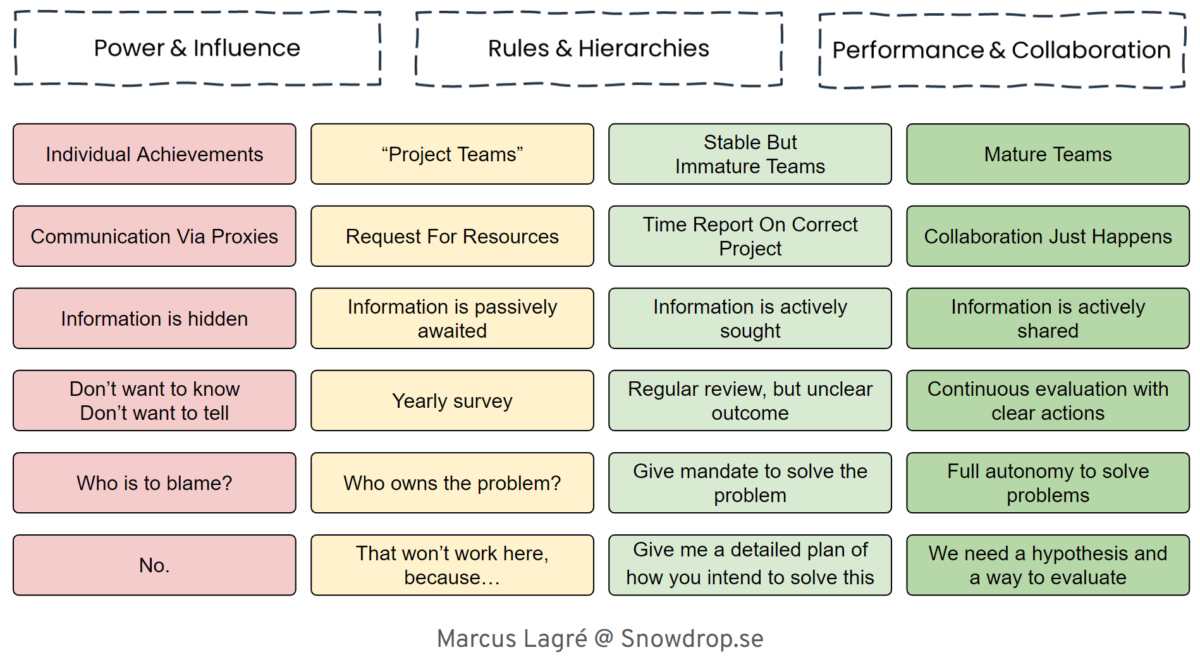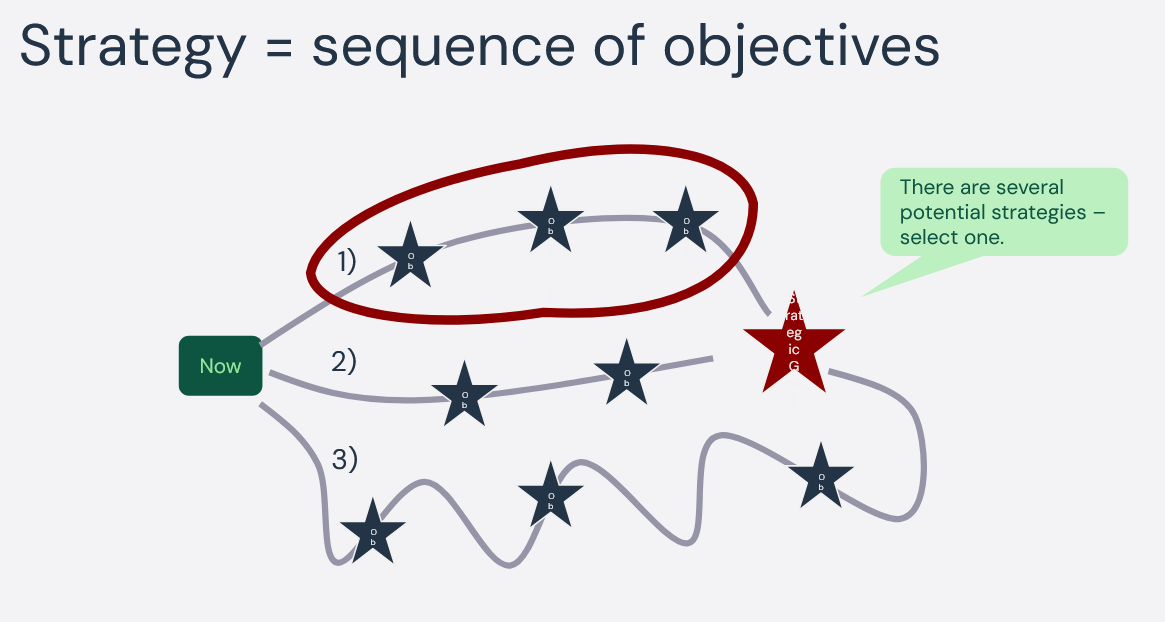In this final article of the series The Performing Organization, we will examine attitudes regarding a need for change.
It’s one thing to recognize that there are problems, it’s quite another to actually do something about it. Often there is a tendency to not address the root cause of a problem, but instead create a work around or simply handle the symptoms caused by the problem.
So, how do we react to a need for change?

No
It is surprisingly common to run into a straight no when a need for change occurs, especially in organizations that focus on personal prestige and accountability.
There is often a fear of challenging the status quo when one’s personal influence is perceived as diluted by the change – for example by decreasing process constraints and increasing team autonomy. When there is a perceived prestige in being the one who has to give the seal of approval, we are likely unwilling to give up or relent some of that influence, in fear of losing our position.
Likewise if we fear blame associated with any kind of failure, we are unlikely to take a chance on challenging how things are done. Instead we might assign a new role, tasked with handling the symptoms caused by the problem. Then we can claim that we did “all we could” to remedy the situation and the new role gets blamed for the failure if things do not improve.
We end up with an abundance of coordinating roles, decision and checkpoints, status meetings, and an ever growing frustration that things are just moving too slow.
That won’t work here, because…
Even if we realize there is a problem and that something has to change, every suggestion has one or more insurmountable challenges. This solution just won’t work here because…
- …we tried something similar before.
- …our company culture is different.
- …this is too complex.
- …people here resist change.
- …our customers won’t allow it.
- …we don’t have time for this.
When you’ve worked as a change agent or transformation manager for a while, this attitude can become almost comical. What is it with these organizations and companies that makes them think that transformations and improvements in other companies are so simple and straightforward? The only thing that actually differs from organizations who fail and the ones that succeed with transformations is the attitude towards how we solve problems!
Studies have consistently shown that entering a situation with the assumption that we will fail increases the likelihood of failure. This is because such an attitude can affect motivation, effort, focus, and the ability to cope with challenges, leading to behaviors that make failure more likely.
We are simply less committed.
Give me a detailed plan
Larger undertakings require some kind of strategic plan, but there is often a tendency to draw up too detailed tactical plans rather than strategic ones.
By that I mean that our strategy should focus on the effects we are trying to achieve rather than what we will do or produce. A good sanity test for the plan is to check whether it focuses on outputs rather than outcomes.
We can have strategic checkpoints, achieving smaller effects that we believe will take us towards a final goal. The gaps between these checkpoints can be gradually filled with execution plans – what we think we need to do or output in order to achieve the effect.
The reason for doing it this way is that the strategic goal should not change, but our tactical approach (our plan of execution) might. If we realize that our assumptions on how to move forward were wrong, we can inspect and adapt the tactical decisions in order to reach the desired effect.
We can still be committed in reaching the strategic goal, even if indeed “that solution won’t work here, because…” At least we tried, gained new knowledge and can try something different!
The main folly of detailed plans is that the more time we spend on it, the more invested we are. We are more reluctant to change and adapt a plan that we have thought long and hard about, even if it proves to be an ineffective way forward.
We need a hypothesis and a way to evaluate
In a truly high performing organization, improvements and changes are no big deal. We see our tactical decisions as hypotheses – we think this is the way forward, so we will try it and see if it works. A failure is not a failure, just a discovery that this was not the right path.
We try new things all the time, in small iterations, where we evaluate continuously in order to verify or falsify our hypothesis.
While this is often seen as the ideal state of many Agile organizations, we still need planning. If we don’t have a strategic plan, we don’t know if we are on the right path or not. Likewise, a rudimentary plan of execution is usually a good idea for undertakings that might take a few weeks or months. We still need to be able to check our status, momentum, and focus regardless whether we are working hypothesis driven or with detailed plans.
And, don’t ever make the mistake of thinking this just happens or that there are no disagreements within this type of organization. Building a culture like this takes a lot of time and effort. It takes a critical mass of people with a will to compromise and sometimes set their own ambitions aside in order to move forward.
It’s not an environment for everyone, but unless the focus is on solving problems and moving forward, the organization and the company will stagnate. There is no innovation without some element of risk and willingness to try.
Summary
The only thing we can be sure of is that things change and unless we are willing to adapt to these changes, the competition will outpace us – because you can bet someone is willing to take the risk!
If we zoom out and observe our behavior, we can assess where our organization’s culture and processes put us. Whether we are rigged to focus on personal influence and power, or if we gravitate towards performance and collaboration.

Few organizations are 100% in the red or 100% in the green – you might not even want to be all the way in the farthest right green column. But if your organization is leaning more towards the red, you are probably finding it difficult to be efficient and effective. You are probably spending a lot of time and money on negotiations between different departments and individuals. You probably have an abundance of roles, whose sole purpose it is to attend meetings to make decisions on other peoples work. This might be where you absolutely want to be and that’s fine, but you will likely find it hard to retain driven, innovative people.
If you want to move more towards the right of the matrix, you have to be committed for the long haul. Change takes stamina and determination. No organization can move from the red, directly to the green. It will have to be a gradual move, passing through the different stages of the matrix.
This is where I see a lot of Agile transformations fail – trying to move from the red to the far green in one swift transformation. It won’t be done. It will have to be a gradual thing. This is one of the reasons why these questions will need to be understood before a transformation is initiated.
Where are we? And where do we actually want to go?



